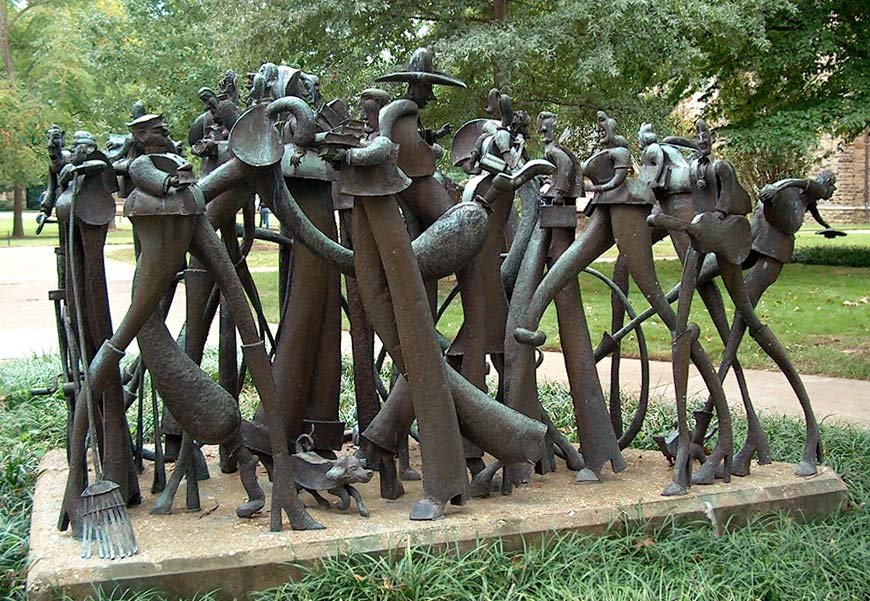
The human figure—mothering, meditating, slinging a spear or dancing the salsa—step center stage in Lawrence Anthony’s inventive imagination. He depicts his original cast of characters in various guises and mediums—from stone, bronze, wood, to plastics, polychromed or natural. “My life’s work in drawing, painting and sculpture has drawn from the human figure as its main source and has dealt with the relationship between figures through the physical, spiritual, and emotional ties that bind us together,” says Anthony, a resident of Summerland, Florida.
“Using the figure, I was always interested in the relationship between the psychological and the visual, design aspect. I use the figure as a recognizable device to do things that challenge the execution. I’ve used traditional tools and instruments but always enjoyed also using industrial techniques and processes to accomplish ends.”
Born in Florence, South Carolina in 1934, Anthony’s first artistic forays were whimsical drawings on the blank front and back pages of Gothic novels his parents ordered from The Book of the Month Club. Hitler and Hirohito with bombs dropping were sketched along side his ideal woman, actress Veronica Lake.
Anthony was graduated from Washington and Lee University and received his MFA in painting from the University of Georgia. His focus on figurative art became sculptural in the late ’50s and early ’60s. He experimented with welding, his figures gradually growing more geometrical, “distorted” and animated; they leaned towards abstract expressionism and the influence of many artists, Picasso, Willem de Kooning and Stuart Davis among them.
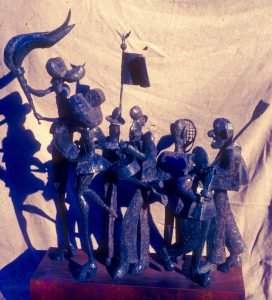
Liberty Leading the People references Delacroix’s commemoration of the French Revolution of 1830, Anthony’s long-legged mistress of liberty brandishes a flag leading a parade of business men in winged tipped shoes and balding seniors to a dubious ending.
The 48×50″ piece was commissioned for a North Carolina bank that, on arrival, rejected its premise. “It was satirical…no doubt about it,” says Anthony. “But it was kind of nasty satirical. It ended up being sold to a woman lobbyist in Washington who moved to Istanbul so the piece went over there.
“Nobody seemed to be paying any attention to the war. It diverted me from happy pleasure in enjoying my work to something angry and sort of violent. A mentor 15 years older than I, asked me ‘Why are you doing this? This is really not who you are and what you can offer.’ I gradually quit because it was obviously to no avail. I’m still mad about the war but then the Iraq thing is equally insane.”
Traveling in Europe after college, Anthony was influenced by his discoveries. In German cathedrals, he found medieval, painted altar pieces and statues, reliefs of figures and demons that were polychromed wood. “The idea of mixing color with sculpture has always been there for me. Trying to combine painting and sculpture is a difficult problem because with sculpture, any time of day in shifting light, things change.”
In London, he admired the work of modernist British sculptors Barbara Hepworth, Kenneth Armitage and Henry Moore. Sculptors at the Royal Academy were working in plastics as a substitute for bronze for its cost and durability. Intrigued, Anthony brought home his observations, most interested in how he might mix color with plastics.
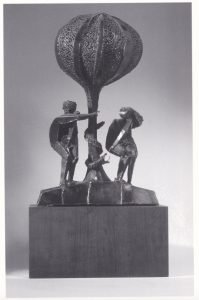
In 1961, Anthony began teaching art history at South-western at Memphis, Tennessee (now Rhodes College). His mission—successfully accomplished as artist-in-residence and eventual chair of the art department—was to integrate art with the academic curriculum.
Anthony’s future works seem created with conscience, irony, sorrow and joy. Adam and Eve, from that early era, enlivens the fallen Biblical duo as each points accusingly to a chosen culprit. Alienated by the Tree of Knowledge between them, the tension and energy holds with the curled snake, his tongue forever ready to strike.
“I was just learning the medium at that point,” says Anthony. “We were studying the medieval period and my first marriage was not going too well. I did a lot sculptures of male and female together in confrontational mode.”
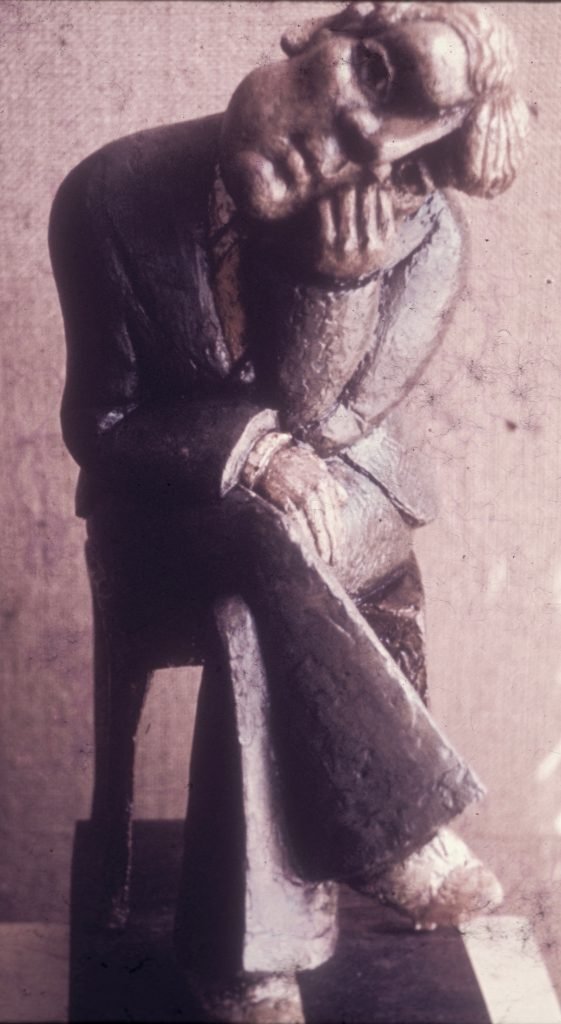
Pensive Man (1963) employs plastics Anthony noted in England. He cast the piece in polychromed polyester resin and fiberglass to show a subtlety of complex emotions within an angular, tightly contained figure. “I liked playing with simple forms.
“He’s a melancholy figure. I did it in the summer of ’63 when my wife, a dancer, was away and I had the studio to myself. More introspective probably because I was alone for three months. In some ways, the figure resembles my father.”
Rhodes College commissioned Anthony’s Campus Life, (above and below) to reflect the lively college scene at a busy intersection in front of the student center. Twenty-six figures animate the interaction of students, faculty, board members, security, buildings and ground staff along with a slew of merry dogs. This stilt-limbed, supple crowd seems off to class, to labs, to the track or even perhaps to swing on a circus trapeze.
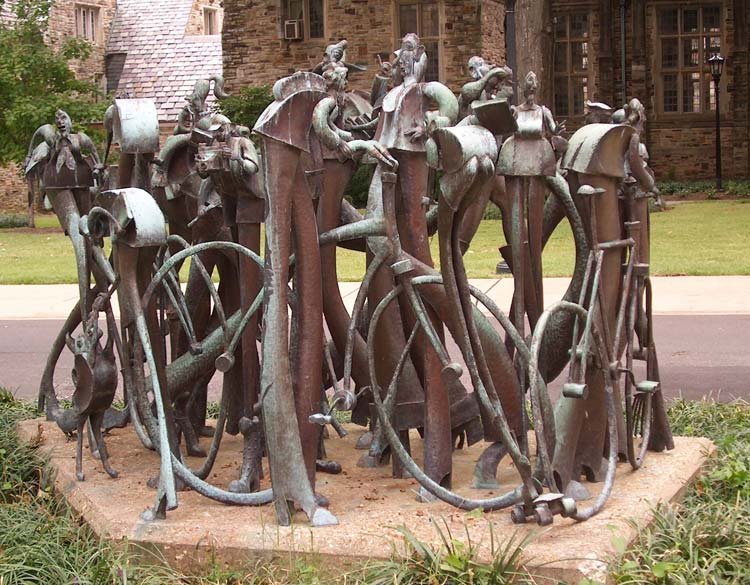
“Back in the 70s,” says Anthony, “there were dogs everywhere; it was part of the freedom that was allowed. They’d come to class. I wanted that sense of traffic, and at the same time, the piece also filled my lifetime interest in using multiple juxtaposed images so there’s a visual rhythm, a fugal sort of thing rather than a whole, a solid. It’s open to air, to space. It’s something that welding allows you to do; it enables you to open up form, to penetrate space and enclose it rather than displacing it as you would with a block of stone or wood.”
Anthony made initial drawings for Campus Life and then, with student help, created the complex, dynamic copper work in chased repoussé, a technique of hammering metal from both the inside and outside. He also developed a way of welding pieces to a three-dimensional, energetic result. Still a popular attraction at Rhodes College, Campus Life spawned a similar, smaller work of Anthony’s for Vanderbilt University.
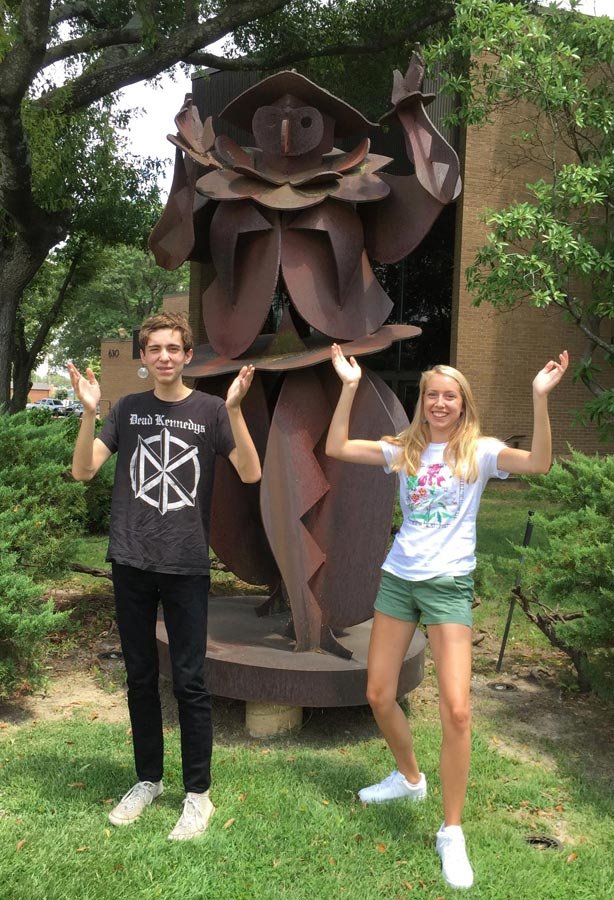
Harlequin (1978) was commissioned as one of a dozen figures representing theater history to welcome visitors to Theater Memphis in Audubon Park. Anthony designed the 13-foot, welded steel, jester as part of “a spatially interacting conversational ensemble.” The figures were later separated and spread over an acre of land.
Through the years Anthony kept experimenting, creating works in oil, encaustic, polymer on tempera, clay, steel, concrete relief, terracotta, polyester resin and fiberglass, woodcut and bronze, his original characters and story-telling thriving In each medium.
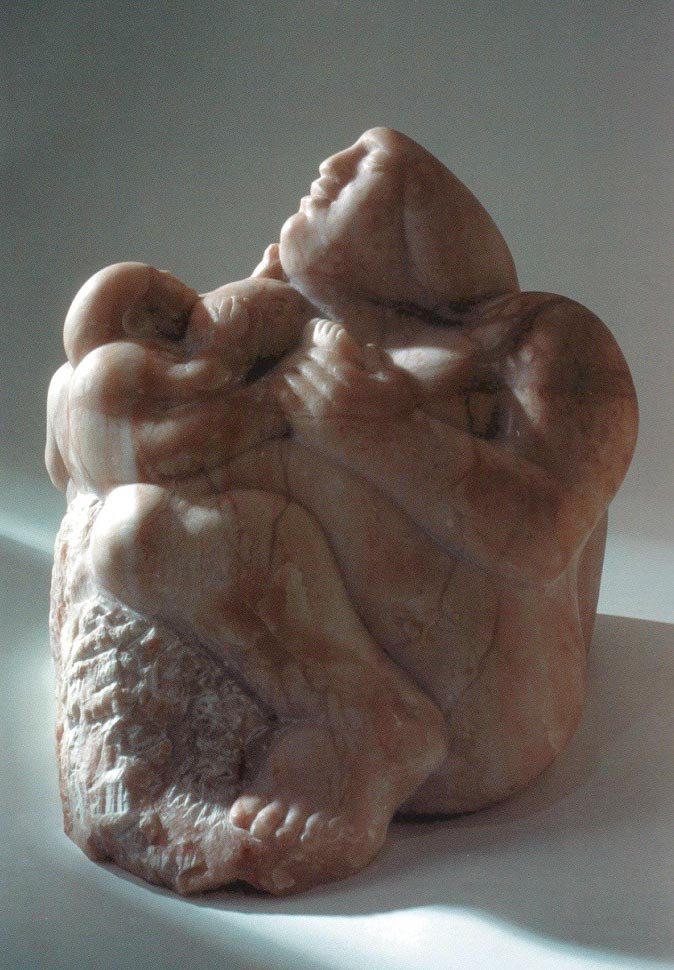
The mother encircles the newborn, the pair becoming one in Mother and Child (1981). The alabaster carving was inspired by Anthony’s wife, Anne, at the birth of their son, Philip. “I had an odd shaped, pyramidal block of stone and I just tried to carve a figure—mother and child—out of this block of stone which dictated the shape of it as much as anything.”
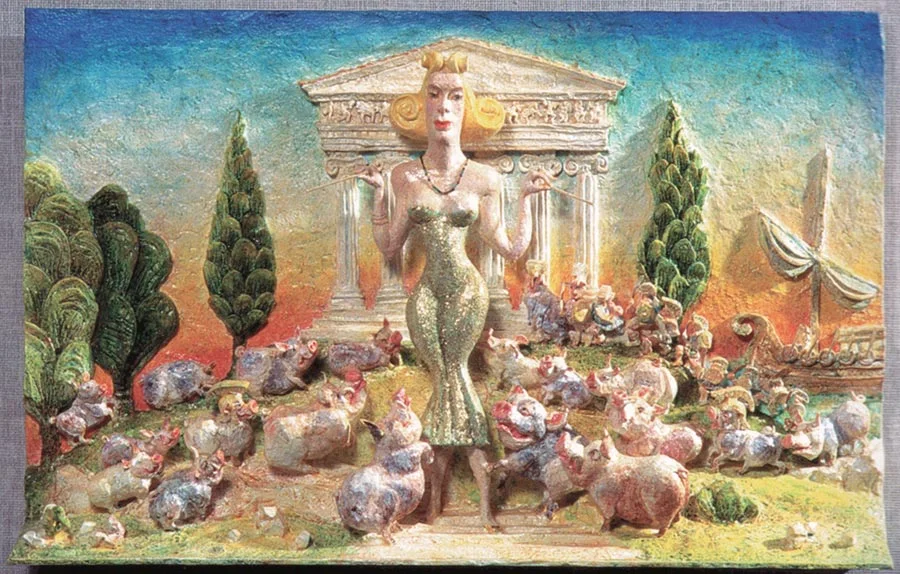
Anthony also tested color on various surfaces. In one of his comic narrative and decorative dioramas, Circe, (1987), the mythical Greek sorceress upstages the temple surrounded by Odysseus’ adoring troops she’s turned into pigs. A curator described Circe as “a voluptuous lounge singer resembling Veronica Lake” casting a magic spell over her fans.
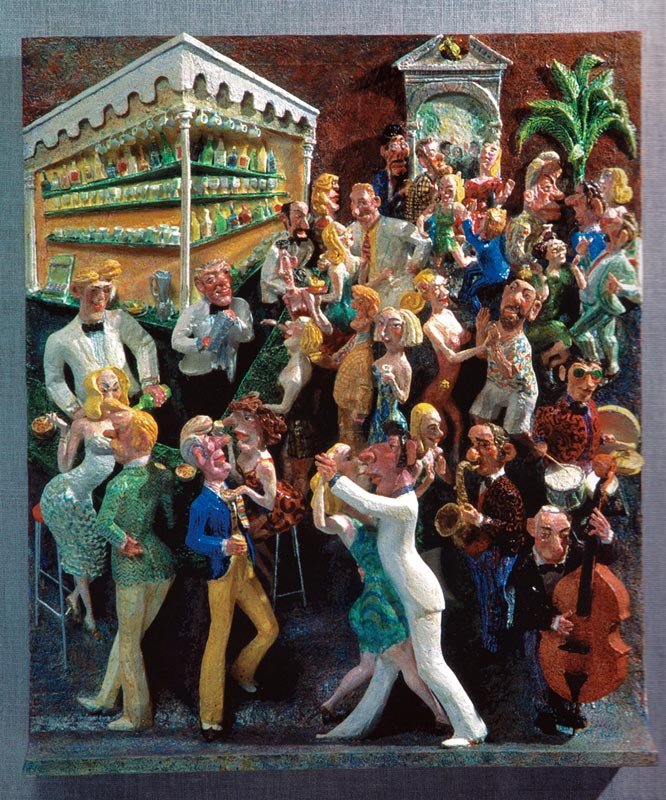
Other high relief, satirical scenes crowd into dioramas that virtually dance off their platforms. Anthony’s theatrical characters, elongated or exaggerated, play up their caricature effect. Bar Scene packs a stage of lively drinkers, dancers, flirters, and bar flies all swaying to their own tropical beats.
“There were some people who inspired the images,” Anthony admits. “Anne at the time was obsessed with going to bars and places that had music and dancing. We’d go to The Pier House in Key West early on when salsa and all types of Latin music was big. She would enlist—with my total approval—what she called ‘dance victims.’ A woman who danced with a Latin looking Romeo type. Cubans guys who came down from Miami and knew how to do all this stuff. We local bumpkins just didn’t have the moves.”
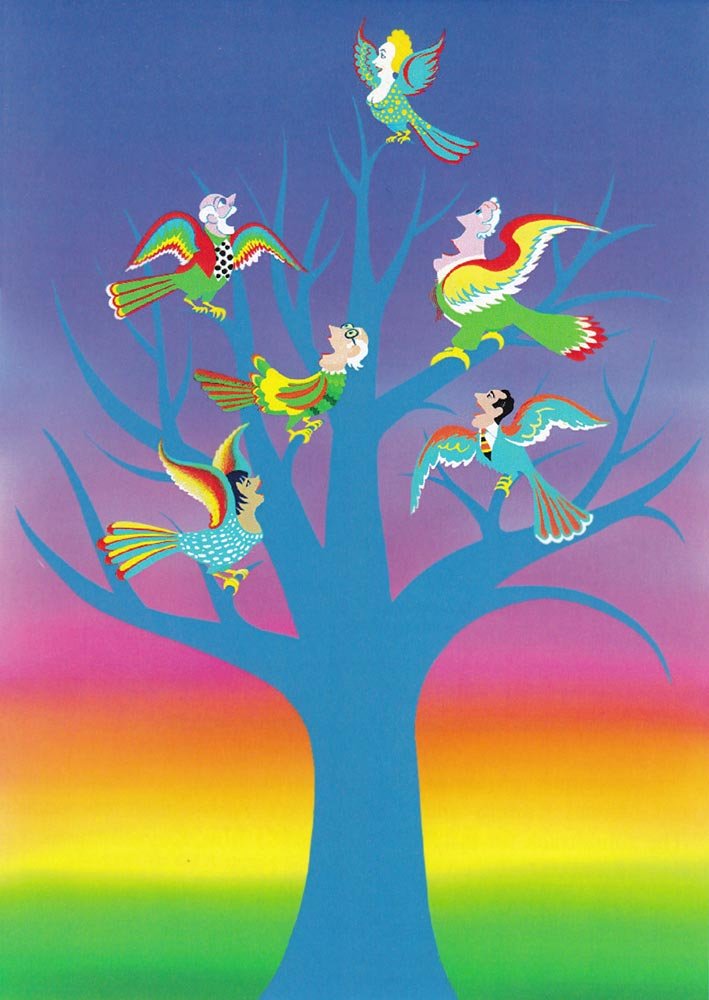
Although Anthony partly gave up sculpture after moving to the Keys in 1987, he retains his penchant for painting and music of all rhythms. His charming posters have graced Key West’s Impromptu Classical Concerts for the past several years.
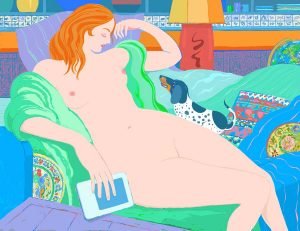
And Anthony continues to paint, his wry and quirky perspective intact. Odalisque with Kindle (2006), morphs Ingres’ elegant La Grande Odalisque of 1814 into a serene modern study of his wife on the sofa with Spotty, the daschund, her Kindle on idle.
He also paints what he calls “ramblings of my imagination…less and less specific topics, more bizarre, mysterious, chaotic. I think it has to do with my concept of the world now. Nothing makes any sense anymore so why should painting?”

Anthony’s varied and highly praised work has been exhibited from the Finkle Gallery, Philadelphia, the Delgado Museum, New Orleans, the Terre des Hommes Pavilion, Montreal, to the U.S. Embassy, Bern, Switzerland and the Virginia Art Museum in Richmond. His pieces are part of collections for CBS Broadcasting and the Metropolitan Opera Company. His portrayal of Caruso as Dick Johnson in Puccini’s Girl of the Golden West, (La Fanciulla del West) was commissioned as a gift to Francis Robinson, “Mr. Metropolitan,” on his retirement as press and tour director of The Metropolitan Opera.
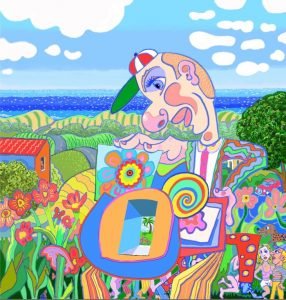
Anthony painted Levi when his grandson was born in 2010. “It’s playful and kind of mysterious at the same time. There’s a lot of stuff going on…it’s kind of an enigma.” he says. “I thought it would be an intriguing thing for him to look at—an imaginative world…and let him make whatever he wants to of it.”
— Elizabeth Meade Howard, art editor
Follow us!Share this post with your friends.

Lawrence Anthony is so gifted. His varied works leave you breathless to know more about the piece and about the artist.
Lon Anthony created such wonderful art. Does anyone know if his work can be found in any galleries in the area?
I knew Lon Anthony 30 years ago at Rhodes College. He was without a doubt one of the most thoughtful, wisest people I have ever encountered….just an astonishing good man. His art is an expression of who he is. I am grateful.
I was a student of Lawrence’s in 1967 and I loved that old shed
where I spent countless hours trying to learn and experiment
with all his sculptural knowledge.
Still count that year as the foundation of my life’s work.
Would love to know that he is well and still doing great art?